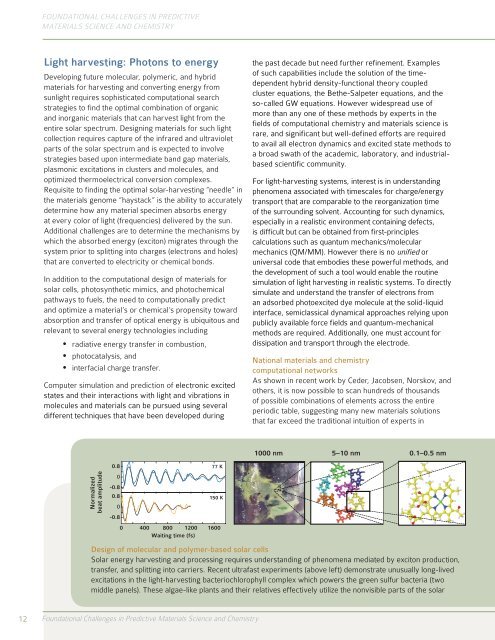Computational Materials Science and Chemistry ... - Office of Science
Computational Materials Science and Chemistry ... - Office of Science
Computational Materials Science and Chemistry ... - Office of Science
Create successful ePaper yourself
Turn your PDF publications into a flip-book with our unique Google optimized e-Paper software.
FOUNDATIONAL CHALLENGES IN PREDICTIVE<br />
MATERIALS SCIENCE AND CHEMISTRY<br />
Light harvesting: Photons to energy<br />
Developing future molecular, polymeric, <strong>and</strong> hybrid<br />
materials for harvesting <strong>and</strong> converting energy from<br />
sunlight requires sophisticated computational search<br />
strategies to find the optimal combination <strong>of</strong> organic<br />
<strong>and</strong> inorganic materials that can harvest light from the<br />
entire solar spectrum. Designing materials for such light<br />
collection requires capture <strong>of</strong> the infrared <strong>and</strong> ultraviolet<br />
parts <strong>of</strong> the solar spectrum <strong>and</strong> is expected to involve<br />
strategies based upon intermediate b<strong>and</strong> gap materials,<br />
plasmonic excitations in clusters <strong>and</strong> molecules, <strong>and</strong><br />
optimized thermoelectrical conversion complexes.<br />
Requisite to finding the optimal solar-harvesting “needle” in<br />
the materials genome “haystack” is the ability to accurately<br />
determine how any material specimen absorbs energy<br />
at every color <strong>of</strong> light (frequencies) delivered by the sun.<br />
Additional challenges are to determine the mechanisms by<br />
which the absorbed energy (exciton) migrates through the<br />
system prior to splitting into charges (electrons <strong>and</strong> holes)<br />
that are converted to electricity or chemical bonds.<br />
In addition to the computational design <strong>of</strong> materials for<br />
solar cells, photosynthetic mimics, <strong>and</strong> photochemical<br />
pathways to fuels, the need to computationally predict<br />
<strong>and</strong> optimize a material’s or chemical’s propensity toward<br />
absorption <strong>and</strong> transfer <strong>of</strong> optical energy is ubiquitous <strong>and</strong><br />
relevant to several energy technologies including<br />
• radiative energy transfer in combustion,<br />
• photocatalysis, <strong>and</strong><br />
• interfacial charge transfer.<br />
Computer simulation <strong>and</strong> prediction <strong>of</strong> electronic excited<br />
states <strong>and</strong> their interactions with light <strong>and</strong> vibrations in<br />
molecules <strong>and</strong> materials can be pursued using several<br />
different techniques that have been developed during<br />
Normalized<br />
beat amplitude<br />
0.8<br />
0<br />
-0.8<br />
0.8<br />
0<br />
-0.8<br />
77 K<br />
150 K<br />
0 400 800 1200 1600<br />
Waiting time (fs)<br />
the past decade but need further refinement. Examples<br />
<strong>of</strong> such capabilities include the solution <strong>of</strong> the timedependent<br />
hybrid density-functional theory coupled<br />
cluster equations, the Bethe-Salpeter equations, <strong>and</strong> the<br />
so-called GW equations. However widespread use <strong>of</strong><br />
more than any one <strong>of</strong> these methods by experts in the<br />
fields <strong>of</strong> computational chemistry <strong>and</strong> materials science is<br />
rare, <strong>and</strong> significant but well-defined efforts are required<br />
to avail all electron dynamics <strong>and</strong> excited state methods to<br />
a broad swath <strong>of</strong> the academic, laboratory, <strong>and</strong> industrialbased<br />
scientific community.<br />
For light-harvesting systems, interest is in underst<strong>and</strong>ing<br />
phenomena associated with timescales for charge/energy<br />
transport that are comparable to the reorganization time<br />
<strong>of</strong> the surrounding solvent. Accounting for such dynamics,<br />
especially in a realistic environment containing defects,<br />
is difficult but can be obtained from first-principles<br />
calculations such as quantum mechanics/molecular<br />
mechanics (QM/MM). However there is no unified or<br />
universal code that embodies these powerful methods, <strong>and</strong><br />
the development <strong>of</strong> such a tool would enable the routine<br />
simulation <strong>of</strong> light harvesting in realistic systems. To directly<br />
simulate <strong>and</strong> underst<strong>and</strong> the transfer <strong>of</strong> electrons from<br />
an adsorbed photoexcited dye molecule at the solid-liquid<br />
interface, semiclassical dynamical approaches relying upon<br />
publicly available force fields <strong>and</strong> quantum-mechanical<br />
methods are required. Additionally, one must account for<br />
dissipation <strong>and</strong> transport through the electrode.<br />
National materials <strong>and</strong> chemistry<br />
computational networks<br />
As shown in recent work by Ceder, Jacobsen, Norskov, <strong>and</strong><br />
others, it is now possible to scan hundreds <strong>of</strong> thous<strong>and</strong>s<br />
<strong>of</strong> possible combinations <strong>of</strong> elements across the entire<br />
periodic table, suggesting many new materials solutions<br />
that far exceed the traditional intuition <strong>of</strong> experts in<br />
1000 nm 5–10 nm 0.1–0.5 nm<br />
Design <strong>of</strong> molecular <strong>and</strong> polymer-based solar cells<br />
Solar energy harvesting <strong>and</strong> processing requires underst<strong>and</strong>ing <strong>of</strong> phenomena mediated by exciton production,<br />
transfer, <strong>and</strong> splitting into carriers. Recent ultrafast experiments (above left) demonstrate unusually long-lived<br />
excitations in the light-harvesting bacteriochlorophyll complex which powers the green sulfur bacteria (two<br />
middle panels). These algae-like plants <strong>and</strong> their relatives effectively utilize the nonvisible parts <strong>of</strong> the solar<br />
12 Foundational Challenges in Predictive <strong>Materials</strong> <strong>Science</strong> <strong>and</strong> <strong>Chemistry</strong>

















